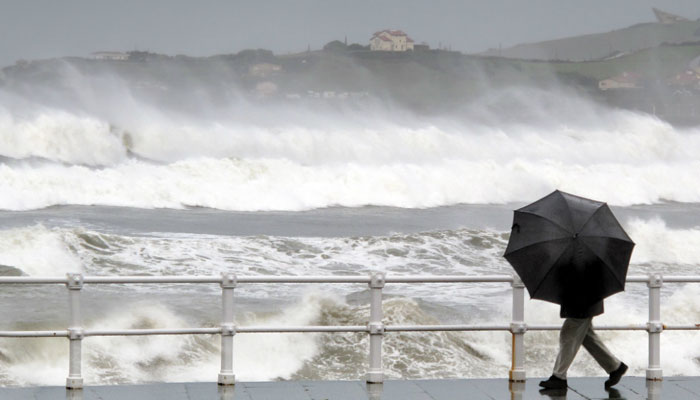Deadly summer of extreme weather around the world
Climate scientists have long warned of severe impacts on the near horizon, and the 21st century has seen more than a few natural disasters made worse or more likely by global warming.
But a cascade of deadly extreme weather this summer could make 2021 the year when climate predictions became a reality that can no longer be ignored. Ahead of next week’s IPCC meeting, here’s a recap, from Death Valley-like temperatures in Canada to rain-filled subway cars in central China with parents lifting their children above the waterline.
In late June, western Canada was caught under a "heat dome", a phenomenon causing scorching temperatures when hot air is trapped by high pressure fronts, and heats up even more as it is pushed back down.
The country broke its record high temperature several times, finally capping at 49.6 degrees Celsius (121 degrees Fahrenheit) in the village of Lytton on June 30. The US states of Washington and Oregon were also affected.
The exact human toll is not yet known but amounts to at least several hundred deaths. A study by a group of leading climate scientists found that the weather conditions would have been "virtually impossible" without human-caused climate change.
The World Weather Attribution group said global warming, caused by greenhouse gas emissions, made the June heat wave at least 150 times more likely to happen.
In mid-July western Europe was hit by devastating floods after torrential rains that ravaged entire villages and left at least 209 people dead in Germany and Belgium, as well as dozens missing.
The flooding also caused damage in Luxembourg, the Netherlands and Switzerland. Up to two months’ worth of rainfall came down in two days in some parts of the region, waterlogging soil that was already near saturation.
Flooding also hit China this month, with cars strewn across the central city of Zhengzhou on Thursday as shocked residents picked through the debris of a historic deluge that has claimed at least 33 lives.
An unprecedented downpour dumped a year’s worth of rain in just three days on the city, instantly overwhelming drains and sending torrents of muddy water through streets, road tunnels and the subway system. Triggered by an alarming drought, the wildfire season is just starting in the American West where thousands of firefighters are already dealing with 80 large blazes.
By the beginning of the week the fires had ravaged more than 4,700 square kilometres (1,800 square miles) of vegetation. The most spectacular blaze is the "Bootleg Fire" in Oregon, which in the space of two weeks has burned the equivalent of the city of Los Angeles in vegetation and forests.
Marcus Kauffman, a specialist with the Oregon forestry department, said the blaze "feeds on itself" and has even been causing its own lightning. In neighbouring California, several villages were evacuated in the face of the advancing "Dixie Fire", which is suspected to have been caused by a tree falling on power cables.
-
 Kate Middleton Is Going Against Old Guards And Camilla: ‘It’s Not Long Till She’s Queen’
Kate Middleton Is Going Against Old Guards And Camilla: ‘It’s Not Long Till She’s Queen’ -
 Drew Barrymore Shares Why Her 'sardines' Tattoo Is Deeply Personal
Drew Barrymore Shares Why Her 'sardines' Tattoo Is Deeply Personal -
 Jennifer Garner Gets Honest About Ben Affleck Split: 'True Partnership' Lost
Jennifer Garner Gets Honest About Ben Affleck Split: 'True Partnership' Lost -
 Joe Jonas 'getting Serious' With Tatiana Gabriela: Source
Joe Jonas 'getting Serious' With Tatiana Gabriela: Source -
 Queen Camilla Turns Territorial And Panicked Seeing Ruthlessness
Queen Camilla Turns Territorial And Panicked Seeing Ruthlessness -
 Kate Middleton's 44th Birthday Coincides With Significant Meghan Anniversary
Kate Middleton's 44th Birthday Coincides With Significant Meghan Anniversary -
 Big Update About 'The Lowdown' At FX
Big Update About 'The Lowdown' At FX -
 Meghan To Stay With Archie And Lilibet As Harry Travels To UK
Meghan To Stay With Archie And Lilibet As Harry Travels To UK -
 Nick Reiner’s Former Attorney Still Saving Him From Blame
Nick Reiner’s Former Attorney Still Saving Him From Blame -
 Harassment Of Keilani Asmus Sparks Matt Kalil Lawsuit Against Ex-wife Haley Kalil
Harassment Of Keilani Asmus Sparks Matt Kalil Lawsuit Against Ex-wife Haley Kalil -
 Miley Cyrus Reveals If She's Open To Acting Again After Years Away From Screen
Miley Cyrus Reveals If She's Open To Acting Again After Years Away From Screen -
 Princess Anne Looses Major Title To King Charles
Princess Anne Looses Major Title To King Charles -
 Kate Middleton Got A Letter Urging Her To ‘consider Forgoing’ Having Prince Louis: Here’s Why
Kate Middleton Got A Letter Urging Her To ‘consider Forgoing’ Having Prince Louis: Here’s Why -
 Bowen Yang Speaks Out Against Criticism Of Lacking 'range'
Bowen Yang Speaks Out Against Criticism Of Lacking 'range' -
 Meghan Markle Source Weighs In On Future Plans For As Ever
Meghan Markle Source Weighs In On Future Plans For As Ever -
 Prince William's Helicopter Ride With Children Raises Eyebrows
Prince William's Helicopter Ride With Children Raises Eyebrows




